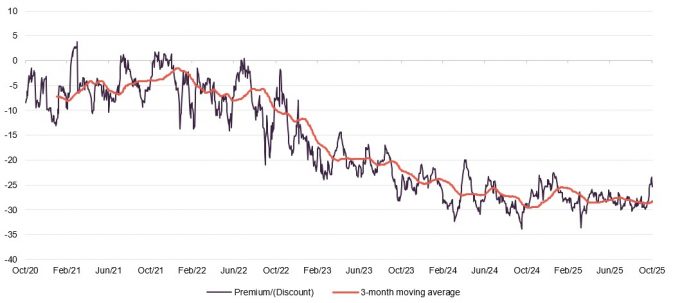Firing up the cylinders
RIT Capital Partners’ (RIT’s) performance has improved after last year’s leadership changes and a shift to a more focused strategy. All three investment pillars – quoted equities, private investments, and uncorrelated strategies – have delivered strong results.
The private portfolio, which had previously held back performance, has seen some profitable exits this year as M&A and IPO activity picked up. More exits are expected soon.
RIT’s high-conviction investments in its quoted equities pillar has paid off, especially in China, Japan, and European defence and aerospace. Its uncorrelated strategies add diversification and help protect against losses. As investors look for more diversification, RIT’s multi-asset approach puts it in a good position to benefit from this trend.
Access growth while managing risk
RIT aims to deliver long-term capital growth, providing shareholders with access to growth opportunities typically inaccessible to individual investors and equity-like returns with lower risk than equity markets. RIT invests in a widely-diversified, global portfolio across a range of asset classes, both quoted and unquoted. It allocates part of the portfolio to exceptional managers to ensure access to the best external talent available.
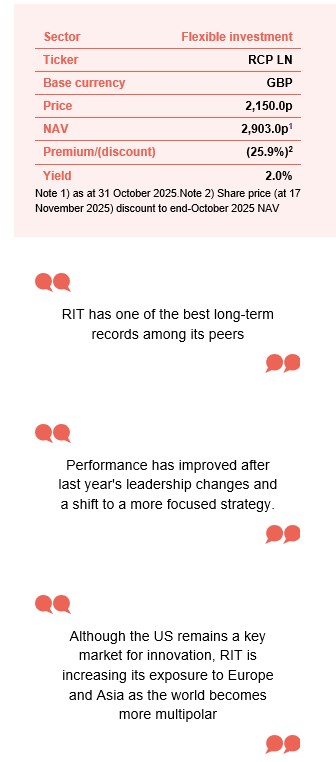
At a glance
Share price and discount
Over the 12-month period ending 31 October 2025, RIT’s shares traded between a 33.7% and a 22.5% discount. Over this period, the average discount was 27.6%. On 17 November 2025, the discount (to the end-October NAV) was 25.9% – just below the 12-month average.
We believe this discount is too large and does not take into account the profitable sales in RIT’s private portfolio or the defensive nature of its multi-asset holdings.
Time period 31 October 2020 to 17 November 2025
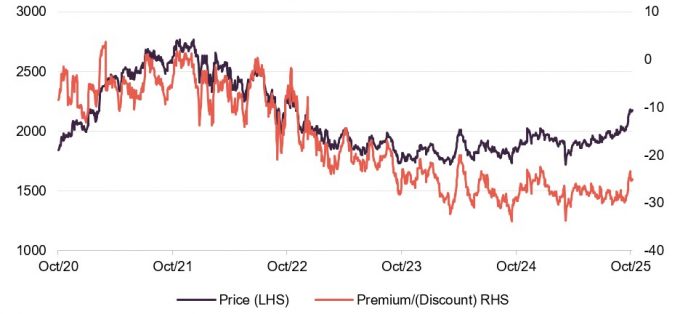
Source: Bloomberg, Marten & Co
Performance over five years
Over the past five years, RIT has beaten CPI inflation +3%, even as inflation rose sharply after COVID and stayed above central banks’ 2% target. However, it has lagged behind the blended MSCI ACWI benchmark, which is heavily weighted towards US tech stocks.
Time period 31 October 2020 to 31 October 2025
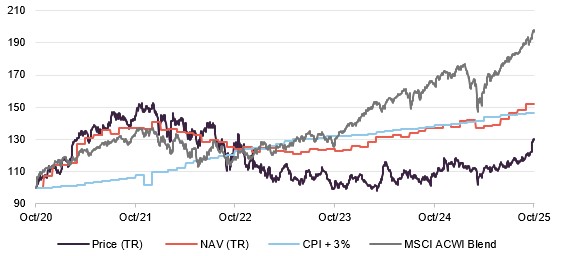
Source: Bloomberg, Marten & Co
| 12 months ended | Share price total return (%) | NAV total return (%) | MSCI ACWI3 total return (%) | CPI +3% per annum (%) |
|---|---|---|---|---|
| 31/10/2021 | 44.4 | 37.1 | 33.2 | 6.1 |
| 31/10/2022 | (13.3) | (9.7) | (10.6) | 13.1 |
| 31/10/2023 | (19.2) | (0.8) | 6.6 | 9.7 |
| 31/10/2024 | 6.9 | 11.8 | 28.7 | 4.7 |
| 31/10/2025 | 19.5 | 13.4 | 21.2 | 6.8 |
Market backdrop
Global investment markets have remained resilient despite ongoing challenges such as trade tensions, rising government debt, and slow GDP growth. Inflation is easing in many countries and interest rates are falling, though the outlook for further rate cuts, especially in the US, remains uncertain. The shift from US equities to more globally diversified strategies plays to RIT’s strengths.
Equity markets have reached record highs, while private markets have seen a recovery in mergers and acquisitions and renewed interest in IPOs. In this environment, RIT has delivered strong results across all three investment areas. Its private portfolio has seen several successful exits, with more possible; thematic equity investments are performing well; and its uncorrelated strategies continue to provide diversified returns. The following section examines the main drivers of performance in RIT’s private and quoted equities portfolios.
Harvest time in private portfolio
Activity has picked up in private markets
Private markets have seen a rebound in activity after a challenging few years with few exits. In the first half of 2025, the US recorded 109 IPOs, the highest since 2021, according to EY. M&A activity has also increased, both of which have boosted RIT’s NAV returns this year.
Figure 1: Realisations in RIT’s private portfolio in 2025
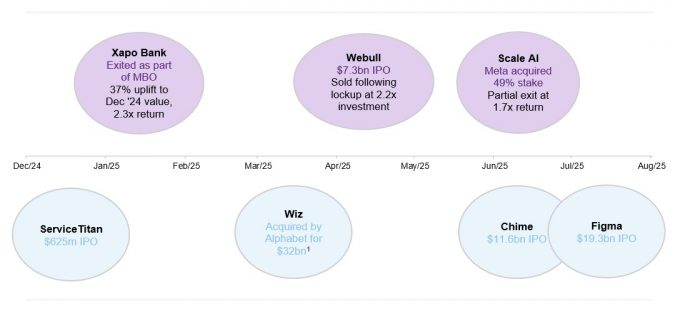
Source: RIT Capital Partners, Marten & Co. Note 1) subject to regulatory approval.
Around 60% of RIT’s directly held private portfolio was sold in the first half of this year, with further sales in its fund investments. Figure 1 shows the timeline of these realisations in 2025, with purple bubbles for direct holdings and blue for fund exits.
Three realisations from RIT’s direct private portfolio in 2025 so far, at large premiums to carrying values
In January, RIT exited fintech firm Xapo Bank as part of a management buyout at a 37% premium to book value, generating a 2.3x return and a 28% IRR. Webull, a commission-free trading platform, went public in April and moved to RIT’s quoted equities portfolio. After a six-month lock-up, RIT sold its Webull investment for a 2.2x return. Meta’s acquisition of a 49% stake in Scale AI valued the company at $29bn, 109% above RIT’s previous valuation.
There have been two IPOs in RIT’s private equity funds, plus ServiceTitan’s listing in December 2024. The most recent were digital bank Chime and website design app Figma. Alphabet’s proposed $32bn acquisition of cloud security firm Wiz, expected to close in 2026, would be its largest ever and significantly increase Wiz’s valuation.
Returns from RIT’s private investment pillar back in line with long-term trend
These activities led to a 9.0% return for RIT’s private portfolio in the first half of 2025, bringing it back in line with its five-year annualised return of 19% and 10-year return of 15%.
Two of RIT’s largest direct private holdings are nearing IPOs: Motive (2.2% of NAV) plans to list by year-end, and Kraken (0.6% of NAV) is expected to list early next year. More details are on pages 10 and 11.
RIT’s private portfolio now makes up 32% of the trust (as of October), down from 40.7% at the end of 2022, and within the board’s 25%-33% target range. With the upcoming IPOs and further portfolio trimming, RIT’s manager aims to reduce exposure further. Proceeds have funded £66.5m in share buybacks this year and have been selectively reinvested in quoted equities and private assets.
The uplifts to book value reflect both conservative private equity valuations and the mature nature of RIT’s portfolio, with 65% invested in pre-2020 vintages (see Figure 2). Figure 3 shows the portfolio’s sector focus, which is mainly technology and healthcare/life sciences, and mostly US-based. RIT invests in later-stage companies with low financial leverage, reducing default risk. Early-stage venture capital exposure is limited. This segment represents less than 10% of RIT’s overall private portfolio (and less than 3% of NAV).
Figure 2: Private fund NAV by vintage year at 30 June 2025
Figure 3: Private investments by sector at 30 June 2025

Source: RIT Capital Partners
Source: RIT Capital Partners
After several slow years, RIT’s manager says recent realisations show its private portfolio approach is working. The manager is reducing the private portfolio to the lower end of the board’s preferred range, helped by these successful exits. However, it remains confident in holdings like Kraken, Motive, and SpaceX, which are covered on page 10. SpaceX, for example, is not available to most investors, highlighting the unique nature of RIT’s private portfolio.
The manager also highlights its unique access to leading fund managers, which provides exposure to top funds, a range of investment years, and co-investment opportunities.
Concentration of equities portfolio
RIT’s quoted equities portfolio weighted towards manager’s high conviction themes, such as a multipolar world
RIT’s private portfolio is mainly focused on technology, while its public portfolio follows strong investment themes. Although the US remains a key market for innovation, RIT is increasing its exposure to Europe and Asia as the world becomes more multipolar. The company looks to benefit from these changes by working with specialist managers.
Since Maggie Fanari became CEO in 2024, a main goal has been to narrow the portfolio across all areas. In quoted equities, RIT is reducing the number of stocks it holds and plans to focus on high-conviction investments, using its network to gain an advantage. This approach is seen with companies like Coupang, the Korean e-commerce firm that moved from RIT’s private to public portfolio after its 2021 listing; Galderma, a Swiss pharmaceutical company RIT knew before its 2024 IPO through its link with EQT; and Seibu, a Japanese transport firm co-invested with hedge fund 3D Opportunity.
The manager is aiming to increase exposure to two key themes: European aerospace and defence, driven by higher defence spending following Russian aggression, and European sovereignty, as recent US policies highlight the need for nations to become more self-reliant in a world with more dispersed economic influence. This shift is affecting supply chains and capital flows across sectors like AI, construction, and materials.
RIT has exited positions in prominent names including Visa and Mastercard
RIT’s move to concentrate its equities portfolio to reflect key thematic trends saw it sell its stakes in Visa, Mastercard, and London Stock Exchange Group after strong performance post-“Liberation Day”. The manager notes both Visa and Mastercard have valuable data and strong management, and could be considered again if valuations become more attractive.
Other high conviction themes include corporate governance reform in Japan, value opportunities in China, and growth in biotech and life sciences. These are mainly accessed through external managers. The manager believes Japanese governance reforms are still at an early stage and could unlock significant value. Confidence in China has grown after the release of the DeepSeek AI model and recent US trade talks, suggesting China is more competitive than expected.
Figure 4: Quoted equities by theme at 30 June 2025
Figure 5: Quoted equities by region at 30 June 2025

Source: RIT Capital Partners
Source: RIT Capital Partners
Although the biotech and life sciences sector had a tough start to 2025, the manager reports a recent rebound. Industry funding slowed after COVID and further declined following policy changes under Trump, but deal activity and clinical trial data have improved since summer. As a result, RIT’s biotech and life science managers have seen a strong recovery.
Asset allocation
Figure 6: Asset allocation by asset type at 31 October 2025
Figure 7: Asset allocation by geography at 31 October 2025

Source: RIT Capital Partners
Source: RIT Capital Partners
Quoted equities remain RIT’s largest allocation at 45%, split between direct holdings (18%) and funds (27%), as shown in Figure 6. Private investments make up 32%, mostly through funds (23%) and 9% held directly at October 2025, down from 35.9% at the end of 2023 after several realisations. The manager expects this to fall further to the high-20% range as more exits occur. The third pillar, uncorrelated strategies, mainly includes absolute return and credit investments via specialist hedge funds (20% of NAV), as well as real assets like gold and government bonds. These have low correlation with equities, adding diversification. This three-pillar approach – quoted equities, private investments, and uncorrelated strategies – supports RIT’s goal of building a diversified, resilient portfolio that can grow steadily through market cycles.
Largest holdings
Figure 8: Five largest direct quoted equity positions at 30 June 2025
| Country | Industry | Value £m | Percentage of NAV (%) | |
|---|---|---|---|---|
| Microsoft | United States | Software & services | 75.3 | 2.0 |
| Webull1 | United States | Retail securities brokerage | 69.6 | 1.9 |
| National Grid | United Kingdom | Utilities | 60.3 | 1.6 |
| Somnigroup | United States | Home furnishings | 56.0 | 1.5 |
| Amazon | United States | E-commerce | 53.6 | 1.4 |
Microsoft
Figure 9: Microsoft share price (USD)
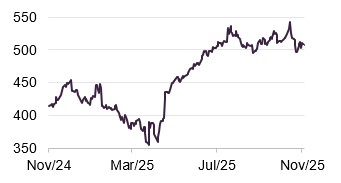
Source: Bloomberg
Microsoft was RIT’s largest direct equity holding at the end of June, making up 2.0% of NAV. The share price is near record highs, up 22.3% over the past year. This follows major investment in AI, including plans to spend $80bn on data centres in 2025 to keep up with rising AI demand. While there are concerns that such high spending could affect short-term margins and cash flow, Microsoft reported a 15% rise in annual revenue to $281.7bn, with Azure cloud sales up 34%.
Webull
Figure 10: Webull share price (USD)
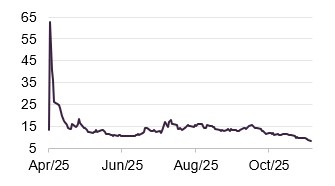
Source: Bloomberg
RIT had held Webull – a brokerage platform offering traditional investor services, in its private portfolio until Webull’s IPO in April 2025. After listing at $13.25, the share price briefly surged above $60 before settling around $14. RIT’s investment included Class A shares, which were subject to a six-month lock-up, and other positions in Webull’s capital structure. At IPO, RIT’s holding was valued at about $121m (£93m) but recorded at a discount due to the lock-up. After the lock-up ended in October, RIT sold its entire stake, achieving a cash return of about 2x its investment. Since RIT’s exit, Webull’s share price has dropped to just over $8.
National Grid
Figure 11: National Grid share price (GBp)
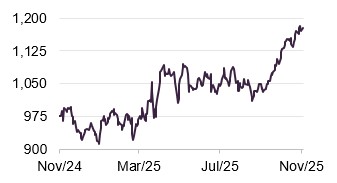
Source: Bloomberg
RIT took a major stake in National Grid in 2024, drawn by its government-regulated cashflows and strong growth prospects from energy infrastructure investment. National Grid, which runs electricity networks in the northeastern US and the UK, has seen its shares rise 24% in 2025 as it starts a £60bn, five-year grid investment plan. This programme is expected to boost regulated returns and support steady growth. In its annual results, National Grid reported a 12% increase in underlying operating profit to £5.4bn and expects earnings per share to grow by 6% to 8% next year.
Somnigroup
Figure 12: Somnigroup share price (USD)
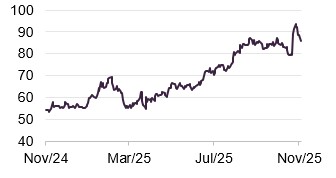
Source: Bloomberg
Formerly named Tempur Sealy International, Somnigroup is a global bedding company producing and selling mattresses and bedding products. Earlier this year, it acquired Mattress Firm, the largest US mattress retailer, for $5bn and changed its name. Somnigroup owns brands like Tempur-Pedic, Sealy, and Stearns & Foster, selling both online and through stores such as Mattress Firm and Dreams. In August, it invested in Fullpower-AI, securing exclusive rights for 10 years to include Fullpower-AI’s Sleeptracker technology in its mattresses. The company expects this partnership to offer unique sleep insights, help develop more targeted products, and strengthen its position in bedding innovation.
Figure 13: Five largest long-only and hedge fund positions at 30 June 2025
| Country | Industry | Value £m | Percentage of NAV (%) | |
|---|---|---|---|---|
| Discerene | Global | All cap, value bias | 189.8 | 5.1 |
| 3D Opportunity | Japan | All cap, diversified | 151.8 | 4.0 |
| Blackrock Strategic Equity | Global | All cap, diversified | 135.4 | 3.6 |
| Springs Opportunities | China | All-cap, diversified | 85.2 | 2.3 |
| HCIF Offshore | United States | All-cap, healthcare | 72.0 | 1.9 |
Discerene
Founded in 2017, Discerene is a Connecticut-based long-only investor that uses value-investing principles and a long-term approach. The team looks for businesses with strong defences against competition or valuable assets, buying them at low prices when they are unpopular to ensure a margin of safety. Discerene aims to make long-term investments in public companies using private equity-style structures. The firm maintains close relationships with its investors, sharing similar values and investment timeframes.
3D Opportunity
3D Opportunity Fund is a hedge fund run by 3D Investment Partners, a value investor focused on Japan. Founded in 2015, the manager works closely with company management to unlock value in Japanese firms. Recent changes, such as a new corporate governance code, more government attention, and rising shareholder activism and private equity interest, suggest further growth potential for Japanese equities.
Figure 14: Five largest direct private positions at 30 June 2025
| Country | Industry | Value £m | Percentage of NAV (%) | |
|---|---|---|---|---|
| Motive | United States | Enterprise software | 80.9 | 2.2 |
| SpaceX | United States | AI & advanced technologies | 31.4 | 0.8 |
| Epic Systems | United States | Healthcare & life sciences | 29.3 | 0.8 |
| Kraken | United States | Fintech | 21.6 | 0.6 |
| Blueground | United States | Consumer | 21.5 | 0.6 |
Motive
RIT’s largest private holding, Motive, is reportedly targeting an IPO before the end of the year (although this may have been delayed by the US government shutdown) and has appointed banks including JPMorgan and Jefferies to facilitate this. The company operates in the transportation logistics sector and provides fleet management services to businesses with the use of AI. Services include financing, maintenance, fuel management, telematics, and driver safety training. Motive’s fleet management software provides real-time data on vehicle performance, driver behaviour, and fuel consumption, which enables their customers to make informed decisions and optimise operations as well as improving safety and compliance. The vast majority of RIT’s underlying investment is in the form of a convertible note that protects shareholder capital in a downside outcome while retaining equity upside through the conversion feature.
SpaceX
RIT increased its investment in space exploration company SpaceX earlier this year, having first invested in 2024. The manager believes SpaceX’s strong market position could lead to significant valuation gains. SpaceX’s valuation reached $425bn in September 2025 after issuing shares to EchoStar as part of a $17bn acquisition. This deal may be transformative, giving SpaceX long-term access to S-band spectrum and global Mobile Satellite Service licences for its Starlink network. This should allow Starlink to offer performance similar to standard 5G mobile services and strengthen its lead in the direct-to-device satellite market. RIT’s manager expects SpaceX to compete with traditional telecoms companies and use its dominant position to gain pricing power.
Kraken
Kraken, a San Francisco-based cryptocurrency exchange, is preparing for an IPO next year with several recent acquisitions and product launches. In October, it bought Small Exchange to launch its own derivatives products in the US, and in May acquired NinjaTrader, whose licence lets Kraken offer and trade crypto features in the US. A major legal hurdle was removed when an SEC lawsuit filed in November 2023 was dropped in March. Kraken’s value reached $15bn after a funding round in September.
Figure 15: Five largest private fund positions at 30 June 2025
| Country | Industry | Value £m | Percentage of NAV (%) | |
|---|---|---|---|---|
| Thrive funds | United States | Growth equity | 130.0 | 3.5 |
| Greenoaks Capital funds | United States | Growth equity | 126.4 | 3.4 |
| Iconiq funds | United States | Growth equity | 108.0 | 2.9 |
| Ribbit Capital funds | United States | Growth equity | 91.5 | 2.4 |
| BDT Capital funds | United States | Private equity | 67.8 | 1.8 |
Thrive funds
Thrive Capital is a New York venture capital firm founded in 2011, investing mainly in technology companies in consumer, software, and financial services. It targets businesses set to disrupt traditional industries and create new markets, working closely with strong leadership teams to support their growth. RIT invested in Thrive in 2012 and has participated in all its flagship funds since. According to RIT’s manager, Thrive has built a strong record by backing major companies like Instagram, Stripe, Spotify, OpenAI, Wiz, GitHub, and Oscar Health, making it difficult for other investors to gain access.
Greenoaks Capital
Venture capital firm Greenoaks, a venture capital firm founded in 2012, invests across different asset classes, sectors and regions, but mainly focuses on technology companies at the mid to early growth stage. It manages $12.6bn as of the end of 2024, with each fund typically backing around 15 companies and making initial investments of $25m to $75m. Notable investments include Coupang, Databricks, Stripe and Wiz. Recent growth in private market M&A has boosted Greenoaks’ returns, especially with Wiz. Greenoaks first invested in Wiz’s Series B round in 2021 and co-led later rounds, committing $300m in total. Earlier this year, Wiz was acquired by Alphabet for $32bn (pending regulatory approval), which is expected to deliver Greenoaks about $2bn from the sale. Greenoaks invested in Scale AI, which Meta bought a 49% stake in at a $29bn valuation in June. This allowed RIT to partially exit its position, achieving a 109% gain on book value.
Figure 16: Five largest absolute return and credit positions at 30 June 2025
| Country | Industry | Value £m | Percentage of NAV (%) | |
|---|---|---|---|---|
| Tresidor funds | Europe | Credit | 168.9 | 4.5 |
| Attestor Value | Global | Credit | 106.6 | 2.8 |
| Atos corporate bond | Europe | Credit | 43.1 | 1.1 |
| ARCM | Asia | Credit | 38.1 | 1.0 |
| Liontree Advisory loan note | United States | Credit | 29.2 | 0.8 |
Tresidor funds
Tresidor is managed by Tresidor Investment Management LLP, a London-based firm investing across European credit markets, including distressed debt and special situations. It focuses on lending to high-quality companies with a low risk of losses, supported by strong collateral, asset value, business quality, liquidity, cashflows, and legal protections.
Attestor Value
Attestor Value is a circa €8.5bn fund managed by Attestor Capital, a London-based private investment firm founded in 2012. The firm specialises in distressed debt and special situations, mainly in Europe. Attestor is recognised for handling complex, illiquid investments and creating value through active management and operational improvements. Its disciplined, value-focused approach involves working closely with company management to unlock value, often through balance sheet changes.
Performance
Five-year track record
Figure 17 shows RIT’s NAV performance against its two relevant indices. Over the past five years, RIT has beaten CPI inflation +3%, even as inflation rose sharply after COVID and stayed above central banks’ 2% target. However, it has lagged behind the blended MSCI ACWI benchmark, which is heavily weighted towards US tech stocks. Earlier this year, market turmoil led to a slight improvement in RIT’s performance relative to this benchmark, highlighting the benefits of its diversified, multi-asset portfolio. The recent spread of returns across different asset classes shows how RIT’s diversification helps it join market rallies while reducing volatility.
Figure 17: RIT versus benchmarks over five years ended 31 October 2025
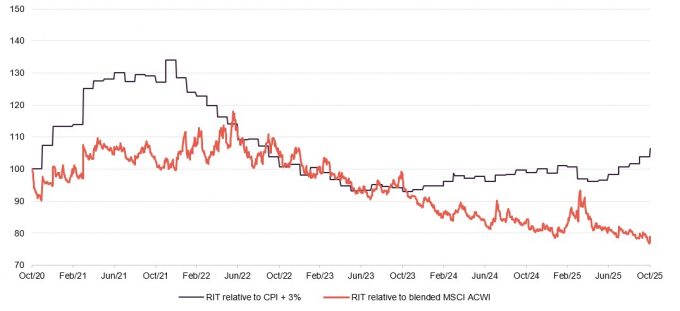
Source: Bloomberg, Marten & Co
Figure 18: Total return cumulative performance over various time periods to 31 October 2025
| 6 months (%) | 1 year (%) | 3 years (%) | 5 years (%) | |
|---|---|---|---|---|
| RIT Capital Partners share price | 16.3 | 19.5 | 3.3 | 29.3 |
| RIT Capital Partners NAV | 12.7 | 13.4 | 25.7 | 55.6 |
| CPI + 3% | 3.4 | 6.8 | 20.3 | 47.0 |
| Blended MSCI ACWI | 22.8 | 21.2 | 66.4 | 97.5 |
| Peer group1 median NAV | 7.0 | 10.1 | 20.1 | 40.9 |
RIT’s NAV returns have not only outpaced inflation over five years but also consistently beaten the average returns of its peer group across all periods, as shown in Figure 18. This performance reflects RIT’s main goal: to deliver long-term capital growth through market cycles while offering some downside protection
Peer group
Up-to-date information on RIT and its peer group is available on the QuotedData website
RIT is part of the AIC‘s Flexible Investment sector, which includes funds able to invest across different asset types. As these funds have varied aims and performance, we have excluded some companies to make a fair comparison for RIT.
RIT is the 3largest trust in our selected peer group, over £1bn bigger than its nearest rival. Its dividend yield is among the lowest, but its share price is also one of the most stable. RIT’s shares trade at a wider discount than most peers, which we believe is not justified.
Due to its size, RIT’s ongoing charges are in the top quarter of its peer group. This is notable given the complex investment process, which usually costs more because of the resources involved.
Figure 19: RIT peer group comparison at 17 November 2025
| Market cap (£m) | Discount (%) | Dividend yield (%) | Ongoing charge (%) | 1-year standard deviation of share price | |
|---|---|---|---|---|---|
| RIT Capital Partners | 3,003 | (25.9) | 2.0 | 0.76 | 9.5 |
| Aberdeen Diversified | 83 | (29.4) | 12.4 | 2.36 | 15.6 |
| Caledonia | 1,994 | (33.5) | 1.9 | 0.87 | 14.1 |
| Capital Gearing | 800 | (2.0) | 2.1 | 0.56 | 2.8 |
| CT Managed Portfolio Growth | 94 | (2.7) | 0.0 | 2.02 | 10.5 |
| CT Managed Portfolio Income | 64 | (2.9) | 6.4 | 2.17 | 11.5 |
| Global Opportunities | 96 | (17.8) | 3.0 | 0.68 | 11.0 |
| Majedie | 130 | (18.9) | 3.4 | 1.40 | 23.8 |
| MIGO Opportunities | 68 | (2.9) | 0.9 | 1.70 | 11.6 |
| Personal Assets | 1,681 | 0.5 | 1.0 | 0.67 | 4.2 |
| Ruffer | 875 | (3.0) | 2.1 | 1.07 | 5.0 |
| Median | 130 | (3.0) | 2.1 | 1.07 | 11.0 |
| RIT rank | 1/11 | 9/11 | 7/11 | 4/11 | 4/11 |
RIT has one of the best long-term records among its peers, thanks to its flexible approach across different asset classes and strong connections in private equity and debt markets. Its performance ranks in the top quarter for all periods up to five years.
Figure 20: Cumulative NAV total return performance over periods ending 31 October 2025
| 6 months (%) | 1 year (%) | 3 years (%) | 5 years (%) | |
|---|---|---|---|---|
| RIT Capital Partners | 12.7 | 13.4 | 25.7 | 55.6 |
| Aberdeen Diversified | (8.9) | (8.4) | (7.7) | 0.0 |
| Caledonia | 7.0 | 6.6 | 18.4 | 80.6 |
| Capital Gearing | 5.1 | 6.5 | 11.1 | 24.7 |
| CT Managed Portfolio Growth | 19.2 | 16.6 | 32.1 | 30.8 |
| CT Managed Portfolio Income | 15.8 | 16.1 | 25.8 | 40.9 |
| Global Opportunities | 6.9 | 12.3 | 18.7 | 60.0 |
| Majedie | 16.5 | 10.1 | 48.1 | 54.0 |
| MIGO Opportunities | 16.3 | 10.6 | 23.4 | 57.1 |
| Personal Assets | 5.6 | 9.8 | 20.1 | 31.4 |
| Ruffer | 6.1 | 8.3 | 6.0 | 35.0 |
| Median | 7.0 | 10.1 | 20.1 | 40.9 |
| RIT rank | 5/11 | 3/11 | 4/11 | 4/11 |
Fund profile
More info at the trust’s website www.ritcap.com
RIT aims for long-term capital growth while managing risk, investing flexibly without following a set benchmark. Its goal is to grow capital faster than relevant indices over time.
RIT seeks to benefit from rising markets and offer some protection when markets fall, aiming to outperform index benchmarks across market cycles.
The board sets risk limits for the manager. RIT is not an absolute return fund and does not behave like one.
There will be times, such as in 2022, when asset values decline. However, over the medium term, the trust’s performance has compared well to even the best absolute return funds.
The manager
RIT is a self-managed UK investment trust that began as the Rothschild Investment Trust, linked to NM Rothschild & Sons. Lord Rothschild became chairman in 1971, and the trust was listed as RIT Capital Partners Plc in August 1988.
J. Rothschild Capital Management (JRCM), a wholly-owned subsidiary, manages RIT. Drawing on the Rothschild family’s global network, JRCM provides access to a wide range of investment opportunities across different asset classes and regions. As of June 2025, JRCM employed 52 staff, including investment professionals and support teams.
Widely diversified, hard to replicate portfolio
RIT invests in a broad, international mix of assets, including both listed and unlisted companies. Its closed-end structure lets it invest in less-liquid, unquoted businesses and take a long-term view, avoiding the short-term pressures of public markets. Investing in private companies also gives RIT access to more opportunities.
Tapping into outside expertise…
Part of the portfolio is allocated to top external managers, giving RIT access to talent and investment opportunities that are often unavailable to retail investors and sometimes closed to all new investors. The Rothschild name helps, but RIT’s real advantage comes from the strong network built by the family and management team, which also provides valuable insights and co-investment opportunities.
…helped by an extensive network of connections
Effective risk management is key to RIT’s approach. JRCM tracks both quantitative and qualitative risks, reports to the board, and aims to hedge against major market and currency risks.
RIT measures its performance against two benchmarks: an absolute target of UK inflation plus three percentage points a year, and an equity benchmark made up of half the MSCI ACWI return in local currencies (converted to sterling) and half the sterling-hedged MSCI ACWI..
SWOT and bull vs. bear analysis
Figure 22: SWOT analysis
| Strengths | Weaknesses |
|---|---|
| Diversified multi-asset approach provides downside protection | Wide discount |
| Realisations in private portfolio picking up, at substantial premiums to book value | Under-performance relative to one of its benchmarks |
| Top quartile performance among peer group | |
| Renewed investor focus on diversification plays to RIT’s strength as a balanced, multi-asset trust | |
| Opportunities | Threats |
| Further realisations from the private portfolio may be on the horizon | Macro and geopolitical landscape worsens, afflicting both private and public markets (although RIT’s diversified portfolio should be able to weather the storm better than most) |
| Investment themes in equities portfolio (including Japan, China, and Europe) may have further to play out | |
| Potential for discount closing |
Figure 23: Bull versus bear case
| Bull | Bear | |
|---|---|---|
| Performance | Long-term track record of solid returns | Discount widening is impacting shareholder returns |
| Dividends | Progressive dividend policy (12 consecutive years of increases) | Modest yield makes it unsuitable for income-seeking investors |
| Outlook | M&A activity in private markets has rebounded, as well as an uptick in IPOs. Equities portfolio weighted to strong investment themes | Macro and geopolitical uncertainty could derail positive momentum in private and public markets |
| Discount | Looks excessively wide, representing a significant potential upside | Large multi-year share buyback programme has not had significant impact on RIT’s discount |
Previous publications
QuotedData has published three previous notes on RIT. You can read the notes by clicking on the links below or by visiting our website.
Figure 24: QuotedData’s previously published notes on RIT
| Title | Note type | Publication date |
|---|---|---|
| A rare opportunity to buy a unique trust | Initiation | 6 April 2023 |
| Change in fortunes on the horizon | Update | 19 June 2024 |
| Riding out the tariff storm | Annual overview | 14 May 2025 |
IMPORTANT INFORMATION
Marten & Co (which is authorised and regulated by the Financial Conduct Authority) was paid to produce this note on RIT Capital Partners Plc.
This note is for information purposes only and is not intended to encourage the reader to deal in the security or securities mentioned within it. Marten & Co is not authorised to give advice to retail clients. The research does not have regard to the specific investment objectives financial situation and needs of any specific person who may receive it.
The analysts who prepared this note are not constrained from dealing ahead of it but, in practice, and in accordance with our internal code of good conduct, will refrain from doing so for the pe until one month after the note’s publication. Nevertheless, they may have an interest in any of the securities mentioned within this note.
This note has been compiled from publicly available information. This note is not directed at any person in any jurisdiction where (by reason of that person’s nationality, residence or otherwise) the publication or availability of this note is prohibited.
Accuracy of Content: Whilst Marten & Co uses reasonable efforts to obtain information from sources which we believe to be reliable and to ensure that the information in this note is up to date and accurate, we make no representation or warranty that the information contained in this note is accurate, reliable or complete. The information contained in this note is provided by Marten & Co for personal use and information purposes generally. You are solely liable for any use you may make of this information. The information is inherently subject to change without notice and may become outdated. You, therefore, should verify any information obtained from this note before you use it.
No Advice: Nothing contained in this note constitutes or should be construed to constitute investment, legal, tax or other advice.
No Representation or Warranty: No representation, warranty or guarantee of any kind, express or implied is given by Marten & Co in respect of any information contained on this note.
Exclusion of Liability: To the fullest extent allowed by law, Marten & Co shall not be liable for any direct or indirect losses, damages, costs or expenses incurred or suffered by you arising out or in connection with the access to, use of or reliance on any information contained on this note. In no circumstance shall Marten & Co and its employees have any liability for consequential or special damages.
Governing Law and Jurisdiction: These terms and conditions and all matters connected with them, are governed by the laws of England and Wales and shall be subject to the exclusive jurisdiction of the English courts. If you access this note from outside the UK, you are responsible for ensuring compliance with any local laws relating to access.
No information contained in this note shall form the basis of, or be relied upon in connection with, any offer or commitment whatsoever in any jurisdiction.
Investment Performance Information: Please remember that past performance is not necessarily a guide to the future and that the value of shares and the income from them can go down as well as up. Exchange rates may also cause the value of underlying overseas investments to go down as well as up. Marten & Co may write on companies that use gearing in a number of forms that can increase volatility and, in some cases, to a complete loss of an investment.
